Advantages of Density in Tensor Network Geometries for Gradient-Based Training
Abstract
1. Introduction
2. Tensor Network Structure
2.1. Bond Dimension and Correlations
2.2. Choice of Structures
2.3. Training with a Surrogate System
2.4. Tensor Budget
2.5. Barren Plateaus
3. Technical Details
4. Results
5. Conclusions and Outlook
Author Contributions
Funding
Data Availability Statement
Acknowledgments
Conflicts of Interest
References
- Cirac, J.I.; Perez-Garcia, D.; Schuch, N.; Verstraete, F. Matrix Product States and Projected Entangled Pair States: Concepts, Symmetries, and Theorems. Rev. Mod. Phys. 2021, 93, 045003. [Google Scholar] [CrossRef]
- Markov, I.L.; Shi, Y. Simulating Quantum Computation by Contracting Tensor Networks. SIAM J. Comput. 2008, 38, 963–981. [Google Scholar] [CrossRef]
- Gray, J.; Chan, G.K.L. Hyperoptimized Approximate Contraction of Tensor Networks with Arbitrary Geometry. Phys. Rev. X 2024, 14, 011009. [Google Scholar] [CrossRef]
- Vidal, G. Efficient Classical Simulation of Slightly Entangled Quantum Computations. Phys. Rev. Lett. 2003, 91, 147902. [Google Scholar] [CrossRef] [PubMed]
- McCulloch, I.P. Infinite Size Density Matrix Renormalization Group, Revisited. arXiv 2008, arXiv:0804.2509. [Google Scholar]
- Vidal, G. Entanglement Renormalization. Phys. Rev. Lett. 2007, 99, 220405. [Google Scholar] [CrossRef] [PubMed]
- Verstraete, F.; Cirac, J.I. Renormalization algorithms for Quantum-Many Body Systems in two and higher dimensions. arXiv 2004, arXiv:cond-mat/0407066. [Google Scholar]
- Georgescu, I.; Ashhab, S.; Nori, F. Quantum simulation. Rev. Mod. Phys. 2014, 86, 153–185. [Google Scholar] [CrossRef]
- Begušić, T.; Gray, J.; Chan, G.K.L. Fast and converged classical simulations of evidence for the utility of quantum computing before fault tolerance. Sci. Adv. 2024, 10, eadk4321. [Google Scholar] [CrossRef]
- Kim, Y.; Eddins, A.; Anand, S.; Wei, K.X.; van den Berg, E.; Rosenblatt, S.; Nayfeh, H.; Wu, Y.; Zaletel, M.; Temme, K.; et al. Evidence for the utility of quantum computing before fault tolerance. Nature 2023, 618, 500–505. [Google Scholar] [CrossRef] [PubMed]
- Verstraete, F.; Murg, V.; Cirac, J. Matrix product states, projected entangled pair states, and variational renormalization group methods for quantum spin systems. Adv. Phys. 2008, 57, 143–224. [Google Scholar] [CrossRef]
- Schollwöck, U. The density-matrix renormalization group in the age of matrix product states. Ann. Phys. 2011, 326, 96–192. [Google Scholar] [CrossRef]
- Stoudenmire, E.M.; Schwab, D.J. Supervised Learning with Quantum-Inspired Tensor Networks. arXiv 2017, arXiv:1605.05775. [Google Scholar]
- Wang, J.; Roberts, C.; Vidal, G.; Leichenauer, S. Anomaly Detection with Tensor Networks. arXiv 2020, arXiv:2006.02516. [Google Scholar]
- Orús, R. Tensor networks for complex quantum systems. Nat. Rev. Phys. 2019, 1, 538–550. [Google Scholar] [CrossRef]
- Christandl, M.; Lysikov, V.; Steffan, V.; Werner, A.H.; Witteveen, F. The resource theory of tensor networks. Quantum 2024, 8, 1560. [Google Scholar] [CrossRef]
- Ye, K.; Lim, L.H. Tensor network ranks. arXiv 2019, arXiv:1801.02662. [Google Scholar]
- Zeng, J.; Li, C.; Sun, Z.; Zhao, Q.; Zhou, G. tnGPS: Discovering Unknown Tensor Network Structure Search Algorithms via Large Language Models (LLMs). arXiv 2024, arXiv:2402.02456. [Google Scholar]
- Li, C.; Sun, Z. Evolutionary Topology Search for Tensor Network Decomposition. In Proceedings of the 37th International Conference on Machine Learning, PMLR 2020, Virtual Event, 13–18 July 2020; Daumé, H., III, Singh, A., Eds.; Proceedings of Machine Learning Research. Volume 119, pp. 5947–5957. [Google Scholar]
- Hikihara, T.; Ueda, H.; Okunishi, K.; Harada, K.; Nishino, T. Automatic structural optimization of tree tensor networks. Phys. Rev. Res. 2023, 5, 013031. [Google Scholar] [CrossRef]
- Evenbly, G. A Practical Guide to the Numerical Implementation of Tensor Networks I: Contractions, Decompositions and Gauge Freedom. arXiv 2022, arXiv:2202.02138. [Google Scholar] [CrossRef]
- Zhao, Y.Q.; Li, R.G.; Jiang, J.Z.; Li, C.; Li, H.Z.; Wang, E.D.; Gong, W.F.; Zhang, X.; Wei, Z.Q. Simulation of quantum computing on classical supercomputers with tensor-network edge cutting. Phys. Rev. A 2021, 104, 032603. [Google Scholar] [CrossRef]
- Cervero Martín, E.; Plekhanov, K.; Lubasch, M. Barren plateaus in quantum tensor network optimization. Quantum 2023, 7, 974. [Google Scholar] [CrossRef]
- Liu, Z.; Yu, L.W.; Duan, L.M.; Deng, D.L. Presence and Absence of Barren Plateaus in Tensor-Network Based Machine Learning. Phys. Rev. Lett. 2022, 129, 270501. [Google Scholar] [CrossRef] [PubMed]
- Menczer, A.; van Damme, M.; Rask, A.; Huntington, L.; Hammond, J.; Xantheas, S.S.; Ganahl, M.; Legeza, Ö. Parallel implementation of the Density Matrix Renormalization Group method achieving a quarter petaFLOPS performance on a single DGX-H100 GPU node. arXiv 2024, arXiv:2407.07411. [Google Scholar] [CrossRef] [PubMed]
- Benenti, G.; Casati, G.; Davide Rossini, G. Entanglement and non-classical correlations. In Principles of Quantum Computation and Information; World Scientifics: Singapore, 2018; Chapter 6; pp. 241–286. [Google Scholar] [CrossRef]
- Horodecki, R.; Horodecki, P.; Horodecki, M.; Horodecki, K. Quantum entanglement. Rev. Mod. Phys. 2009, 81, 865–942. [Google Scholar] [CrossRef]
- Horodecki, P.; Rudnicki, Ł.; Życzkowski, K. Multipartite entanglement. arXiv 2024, arXiv:2409.04566. [Google Scholar]
- Nielsen, M.A.; Chuang, I.L. Introduction to Quantum Mechanics. In Quantum Computation and Quantum Information: 10th Anniversary Edition; Cambridge University Press: Cambridge, UK, 2010; pp. 60–119. [Google Scholar]
- Orus, R. A Practical Introduction to Tensor Networks: Matrix Product States and Projected Entangled Pair States. Ann. Phys. 2014, 349, 117–158. [Google Scholar] [CrossRef]
- Sharma, M.; Markopoulos, P.P.; Saber, E.; Asif, M.S.; Prater-Bennette, A. Convolutional Auto-Encoder with Tensor-Train Factorization. In Proceedings of the 2021 IEEE/CVF International Conference on Computer Vision Workshops (ICCVW), Montreal, BC, Canada, 11–17 October 2021; pp. 198–206. [Google Scholar] [CrossRef]
- Su, Z.; Zhou, Y.; Mo, F.; Simonsen, J.G. Language Modeling Using Tensor Trains. arXiv 2024, arXiv:2405.04590. [Google Scholar]
- Oseledets, I.V. Tensor-Train Decomposition. SIAM J. Sci. Comput. 2011, 33, 2295–2317. [Google Scholar] [CrossRef]
- Affleck, I.; Kennedy, T.; Lieb, E.H.; Tasaki, H. Rigorous Results on Valence-Bond Ground States in Antiferromagnets. Phys. Rev. Lett. 1987, 59, 799–802. [Google Scholar] [CrossRef]
- Evenbly, G.; Vidal, G. Tensor Network States and Geometry. J. Stat. Phys. 2011, 145, 891–918. [Google Scholar] [CrossRef]
- Eisert, J.; Cramer, M.; Plenio, M.B. Area Laws for the Entanglement Entropy—A Review. Rev. Mod. Phys. 2010, 82, 277–306. [Google Scholar] [CrossRef]
- Shi, Y.Y.; Duan, L.M.; Vidal, G. Classical simulation of quantum many-body systems with a tree tensor network. Phys. Rev. A 2006, 74, 022320. [Google Scholar] [CrossRef]
- Okunishi, K.; Ueda, H.; Nishino, T. Entanglement bipartitioning and tree tensor networks. Prog. Theor. Exp. Phys. 2023, 2023, 023A02. [Google Scholar] [CrossRef]
- Haghshenas, R.; O’Rourke, M.J.; Chan, G.K.L. Conversion of projected entangled pair states into a canonical form. Phys. Rev. B 2019, 100, 054404. [Google Scholar] [CrossRef]
- Hyatt, K.; Stoudenmire, E.M. DMRG Approach to Optimizing Two-Dimensional Tensor Networks. arXiv 2020, arXiv:1908.08833. [Google Scholar]
- Hikihara, T.; Ueda, H.; Okunishi, K.; Harada, K.; Nishino, T. Visualization of Entanglement Geometry by Structural Optimization of Tree Tensor Network. arXiv 2024, arXiv:2401.16000. [Google Scholar]
- Lu, J.; Gong, P.; Ye, J.; Zhang, J.; Zhang, C. A Survey on Machine Learning from Few Samples. arXiv 2023, arXiv:2009.02653. [Google Scholar] [CrossRef]
- Fuksa, J.; Götte, M.; Roth, I.; Eisert, J. A quantum inspired approach to learning dynamical laws from data—block-sparsity and gauge-mediated weight sharing. Mach. Learn. Sci. Technol. 2024, 5, 025064. [Google Scholar] [CrossRef]
- Cerezo, M.; Verdon, G.; Huang, H.Y.; Cincio, L.; Coles, P.J. Challenges and opportunities in quantum machine learning. Nat. Comput. Sci. 2022, 2, 567–576. [Google Scholar] [CrossRef] [PubMed]
- Wu, X.C.; Di, S.; Cappello, F.; Finkel, H.; Alexeev, Y.; Chong, F.T. Memory-Efficient Quantum Circuit Simulation by Using Lossy Data Compression. arXiv 2018, arXiv:1811.05630. [Google Scholar]
- Pan, F.; Gu, H.; Kuang, L.; Liu, B.; Zhang, P. Efficient Quantum Circuit Simulation by Tensor Network Methods on Modern GPUs. arXiv 2024, arXiv:2310.03978. [Google Scholar] [CrossRef]
- Sanchez-Ramirez, S.; Conejero, J.; Lordan, F.; Queralt, A.; Cortes, T.; Badia, R.M.; Garcia-Saez, A. RosneT: A Block Tensor Algebra Library for Out-of-Core Quantum Computing Simulation. In Proceedings of the 2021 IEEE/ACM Second International Workshop on Quantum Computing Software (QCS), St. Louis, MO, USA, 15 November 2021; IEEE: Piscataway, NJ, USA, 2021; pp. 1–8. [Google Scholar] [CrossRef]
- Vidal, G. Efficient Simulation of One-Dimensional Quantum Many-Body Systems. Phys. Rev. Lett. 2004, 93, 040502. [Google Scholar] [CrossRef] [PubMed]
- Hashizume, T.; Halimeh, J.C.; McCulloch, I.P. Hybrid infinite time-evolving block decimation algorithm for long-range multidimensional quantum many-body systems. Phys. Rev. B 2020, 102, 035115. [Google Scholar] [CrossRef]
- McClean, J.R.; Boixo, S.; Smelyanskiy, V.N.; Babbush, R.; Neven, H. Barren plateaus in quantum neural network training landscapes. Nat. Commun. 2018, 9, 4812. [Google Scholar] [CrossRef] [PubMed]
- Cerezo, M.; Larocca, M.; García-Martín, D.; Diaz, N.L.; Braccia, P.; Fontana, E.; Rudolph, M.S.; Bermejo, P.; Ijaz, A.; Thanasilp, S.; et al. Does provable absence of barren plateaus imply classical simulability? Or, why we need to rethink variational quantum computing. arXiv 2024, arXiv:2312.09121. [Google Scholar]
- Schuld, M.; Killoran, N. Is Quantum Advantage the Right Goal for Quantum Machine Learning? PRX Quantum 2022, 3, 030101. [Google Scholar] [CrossRef]
- Basheer, A.; Feng, Y.; Ferrie, C.; Li, S.; Pashayan, H. On the Trainability and Classical Simulability of Learning Matrix Product States Variationally. arXiv 2024, arXiv:2409.10055. [Google Scholar]
- Miao, Qiang and Barthel, Thomas Isometric tensor network optimization for extensive Hamiltonians is free of barren plateaus. Phys. Rev. A 2024, 109, L050402. [CrossRef]
- Liu, D.C.; Nocedal, J. On the limited memory BFGS method for large scale optimization. Math. Program. 1989, 45, 503–528. [Google Scholar] [CrossRef]
- Baydin, A.G.; Pearlmutter, B.A.; Radul, A.A.; Siskind, J.M. Automatic differentiation in machine learning: A survey. arXiv 2018, arXiv:1502.05767. [Google Scholar]
- Gray, J. quimb: A python package for quantum information and many-body calculations. J. Open Source Softw. 2018, 3, 819. [Google Scholar] [CrossRef]
- Bradbury, J.; Frostig, R.; Hawkins, P.; Johnson, M.J.; Leary, C.; Maclaurin, D.; Necula, G.; Paszke, A.; VanderPlas, J.; Wanderman-Milne, S.; et al. JAX: Composable Transformations of Python+NumPy Programs, Software Version 0.3.13; GitHub, Inc.: San Francisco, CA, USA, 2018; Available online: http://github.com/jax-ml/jax (accessed on 19 January 2025).
- MareNostrum 5. Available online: https://www.bsc.es/marenostrum/marenostrum-5 (accessed on 19 January 2025).
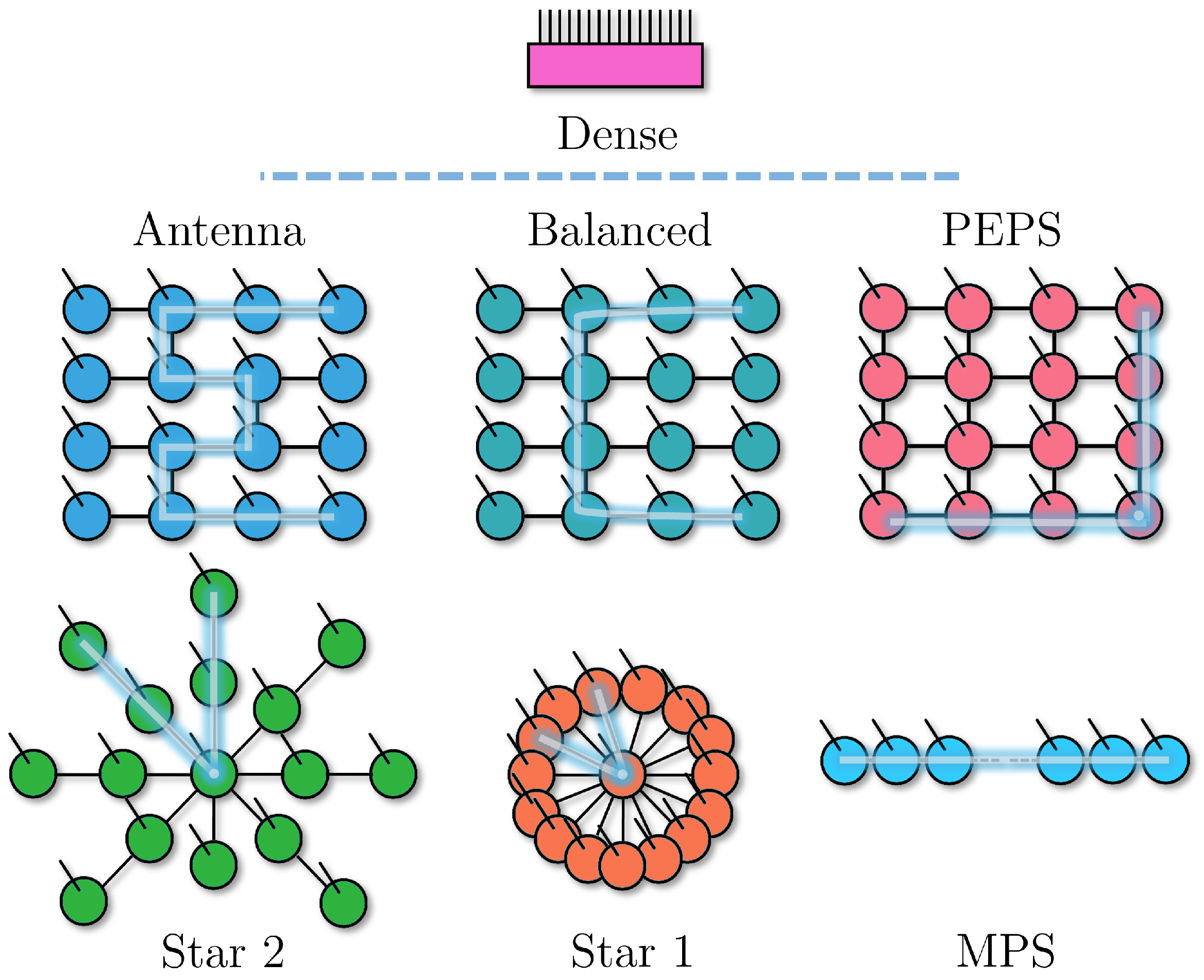
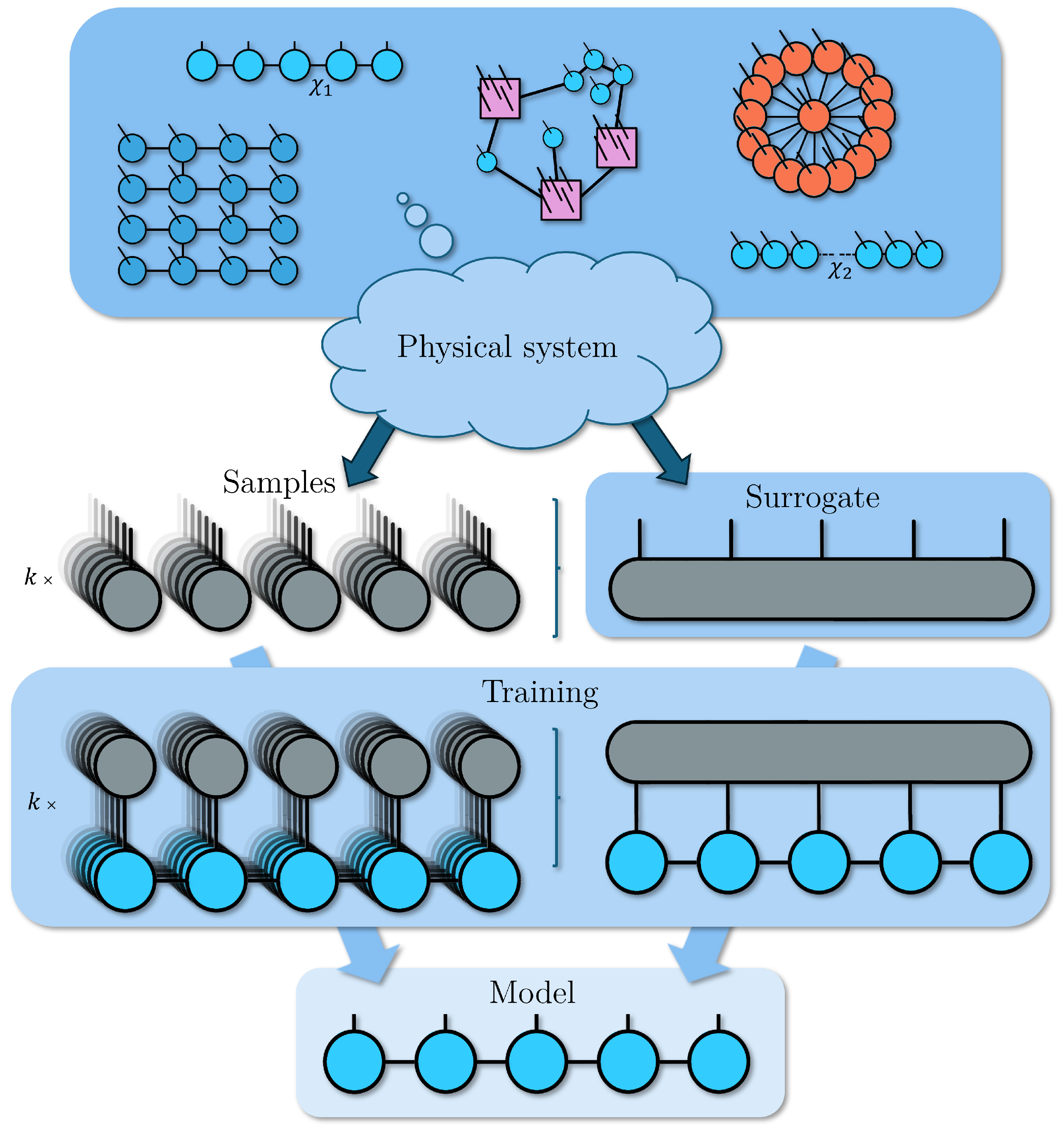
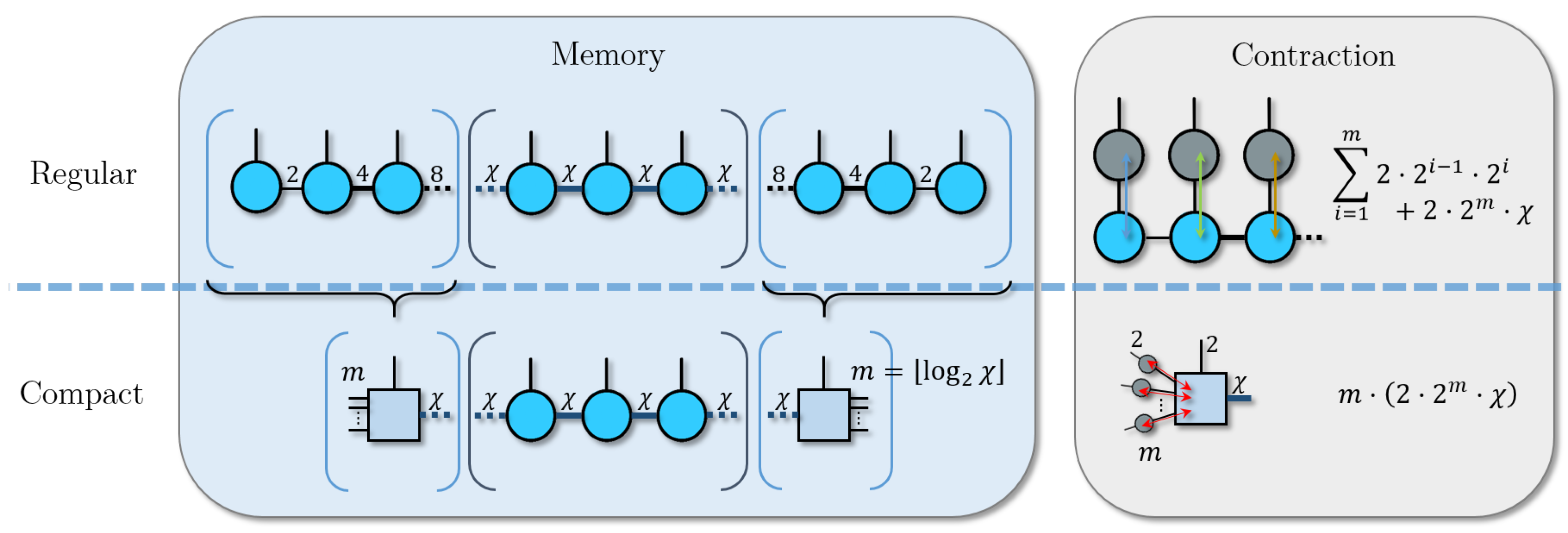
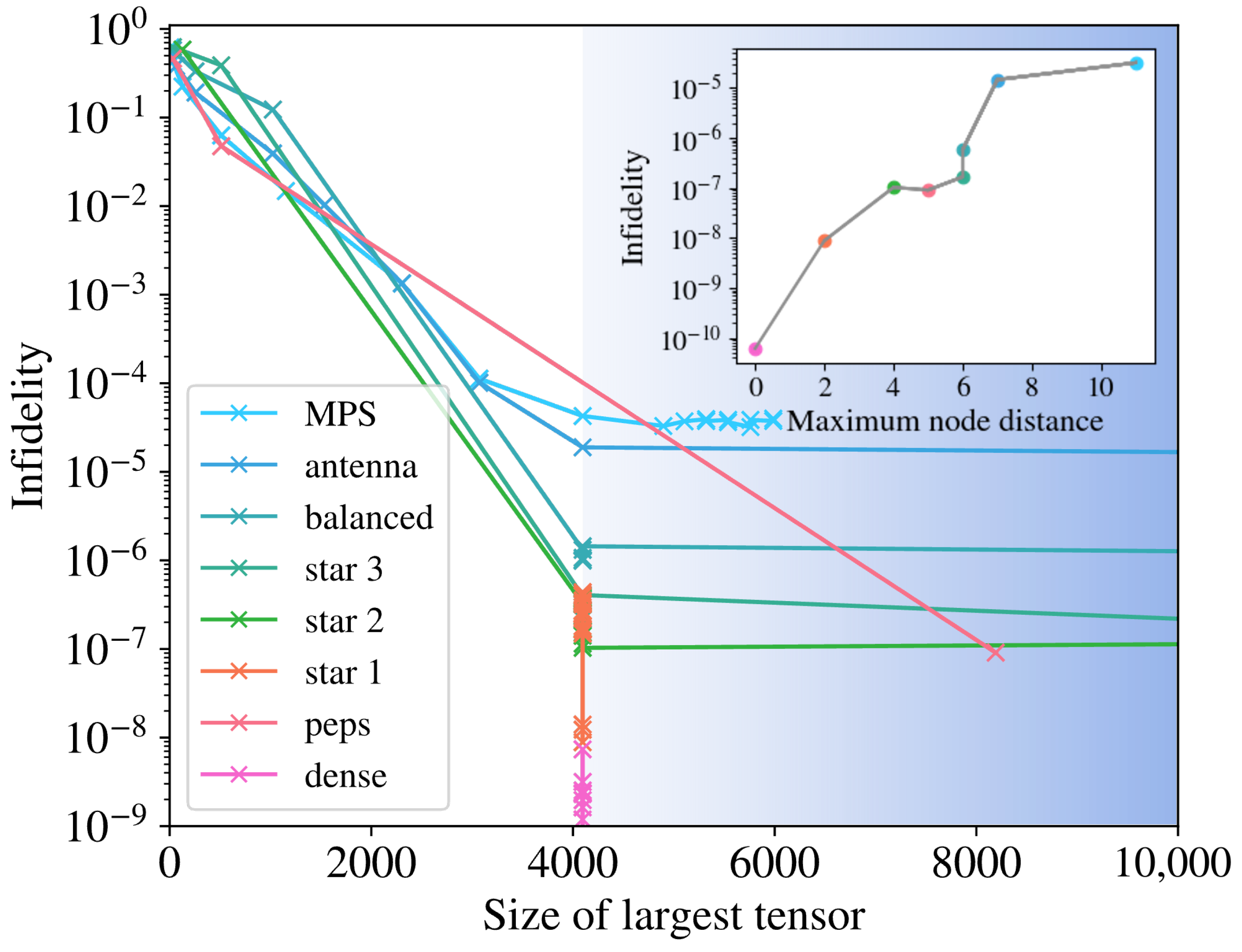
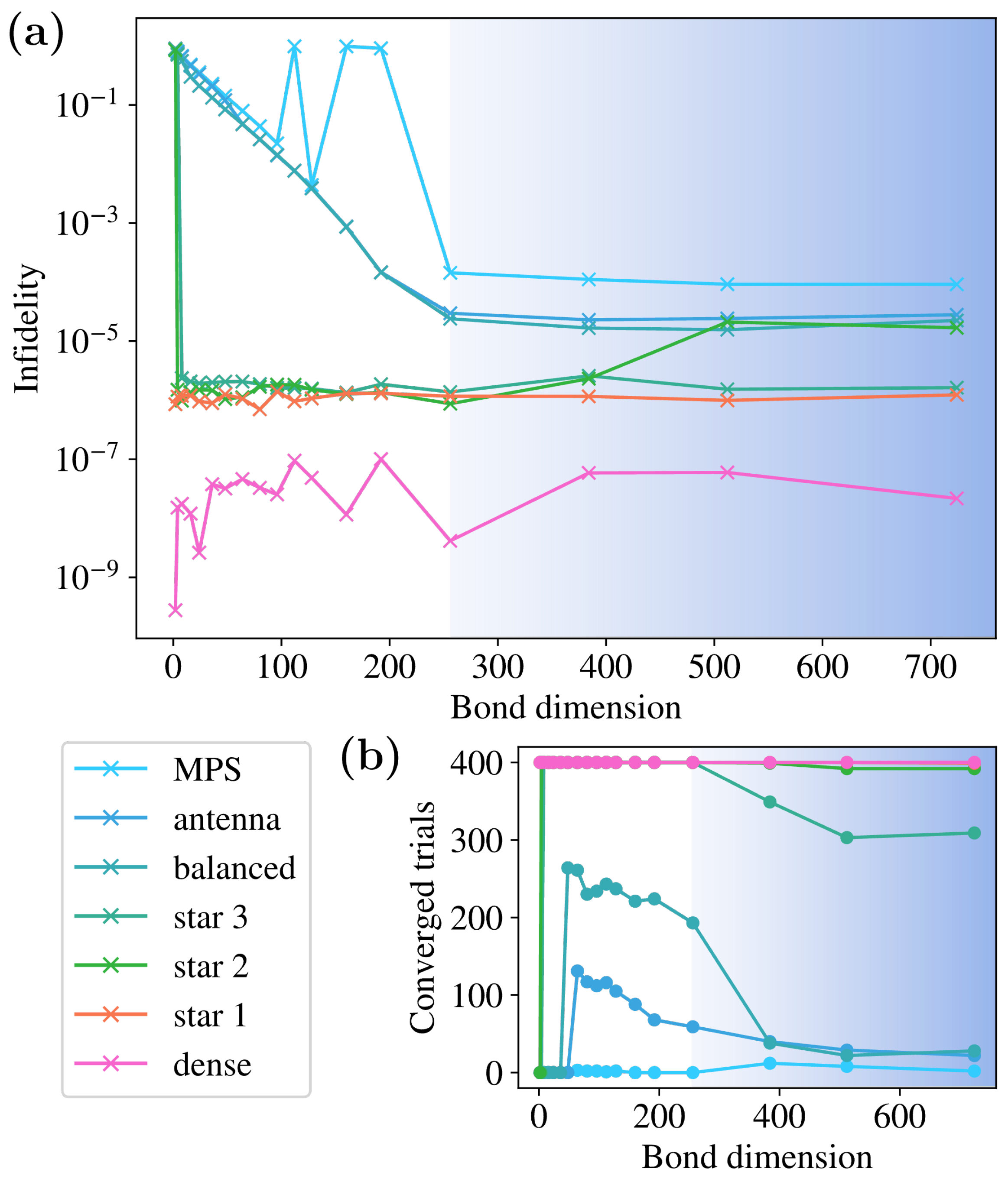
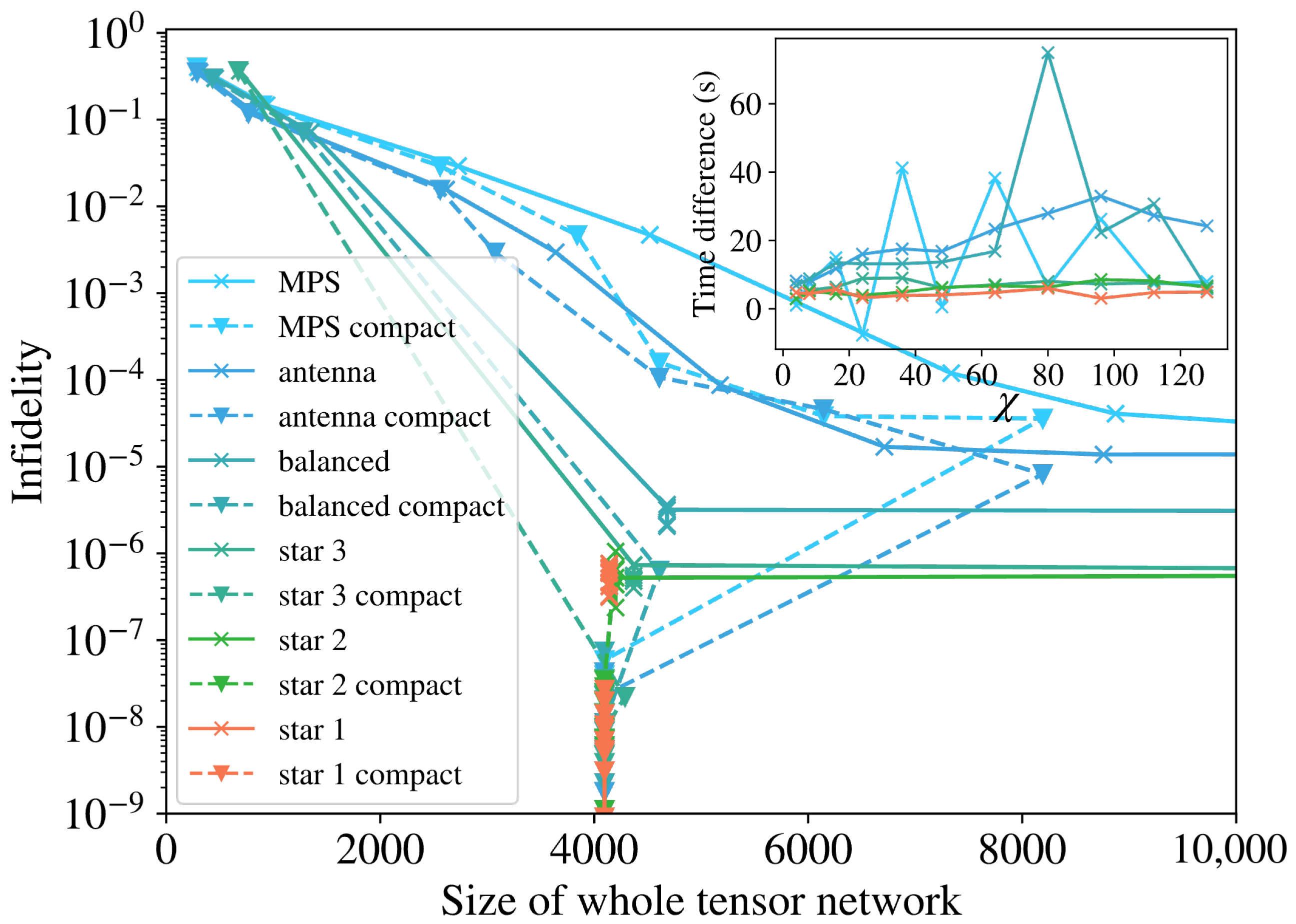
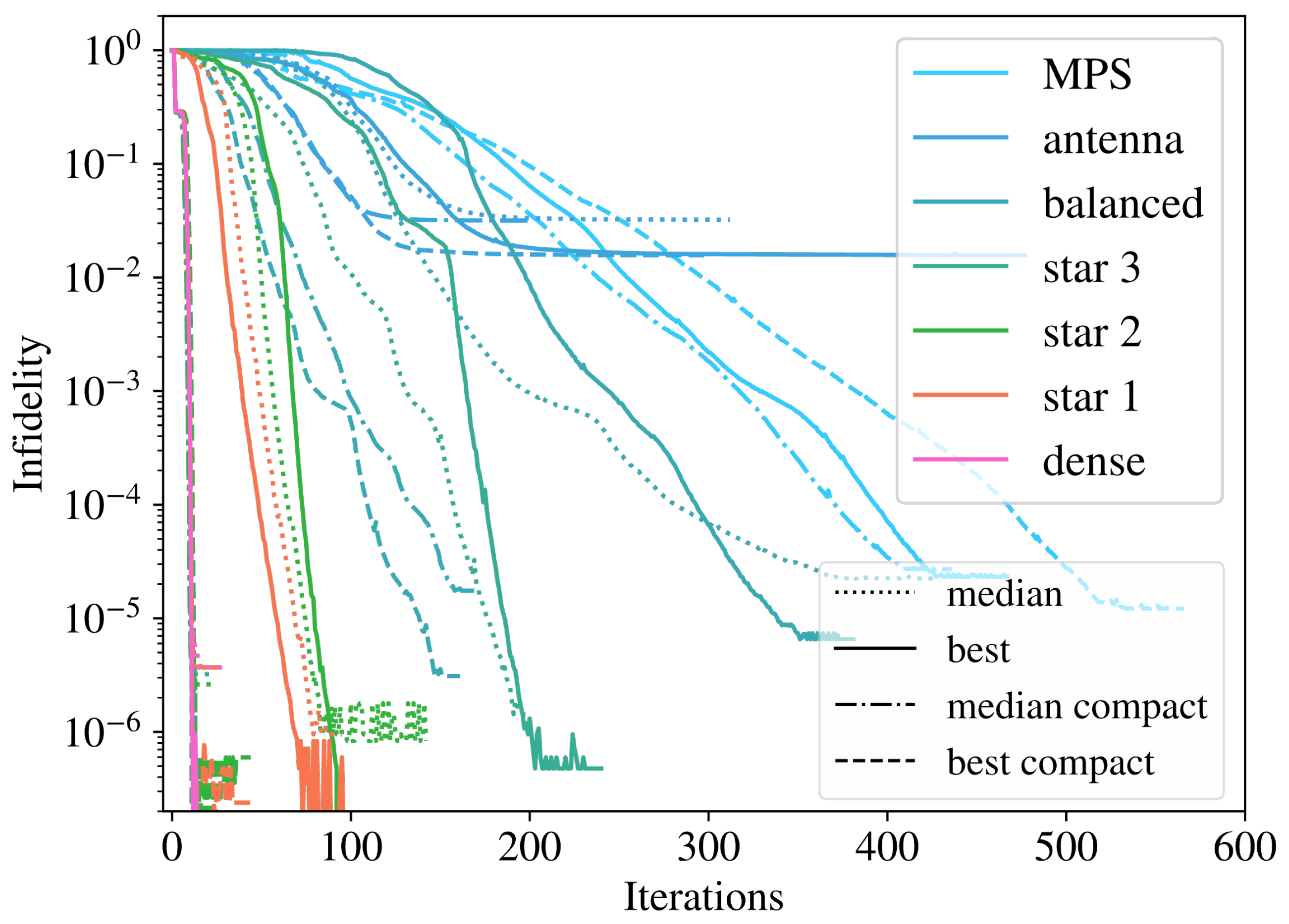
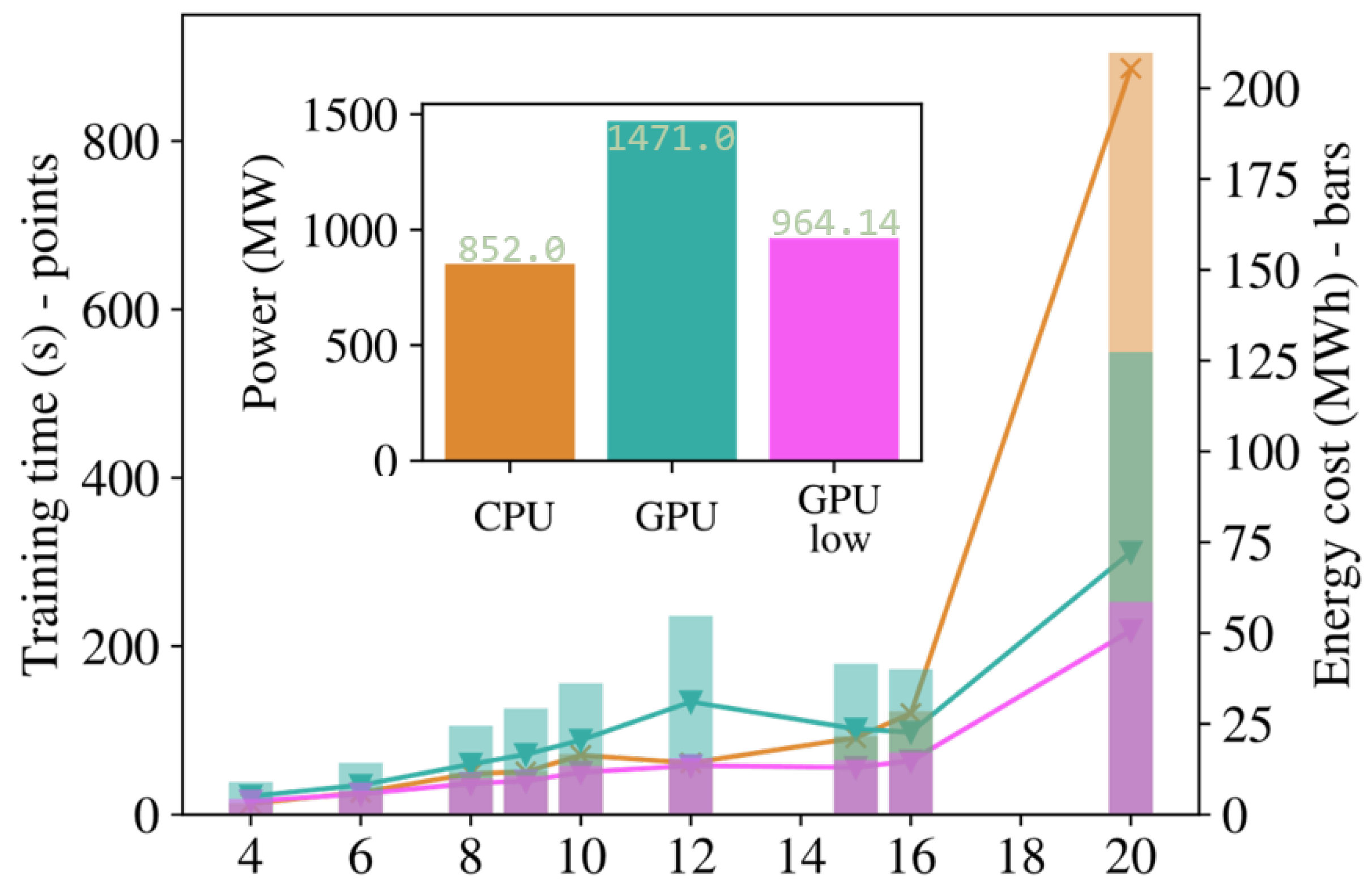
Disclaimer/Publisher’s Note: The statements, opinions and data contained in all publications are solely those of the individual author(s) and contributor(s) and not of MDPI and/or the editor(s). MDPI and/or the editor(s) disclaim responsibility for any injury to people or property resulting from any ideas, methods, instructions or products referred to in the content. |
© 2025 by the authors. Licensee MDPI, Basel, Switzerland. This article is an open access article distributed under the terms and conditions of the Creative Commons Attribution (CC BY) license (https://creativecommons.org/licenses/by/4.0/).
Share and Cite
Masot-Llima, S.; Garcia-Saez, A. Advantages of Density in Tensor Network Geometries for Gradient-Based Training. Algorithms 2025, 18, 70. https://doi.org/10.3390/a18020070
Masot-Llima S, Garcia-Saez A. Advantages of Density in Tensor Network Geometries for Gradient-Based Training. Algorithms. 2025; 18(2):70. https://doi.org/10.3390/a18020070
Chicago/Turabian StyleMasot-Llima, Sergi, and Artur Garcia-Saez. 2025. "Advantages of Density in Tensor Network Geometries for Gradient-Based Training" Algorithms 18, no. 2: 70. https://doi.org/10.3390/a18020070
APA StyleMasot-Llima, S., & Garcia-Saez, A. (2025). Advantages of Density in Tensor Network Geometries for Gradient-Based Training. Algorithms, 18(2), 70. https://doi.org/10.3390/a18020070






